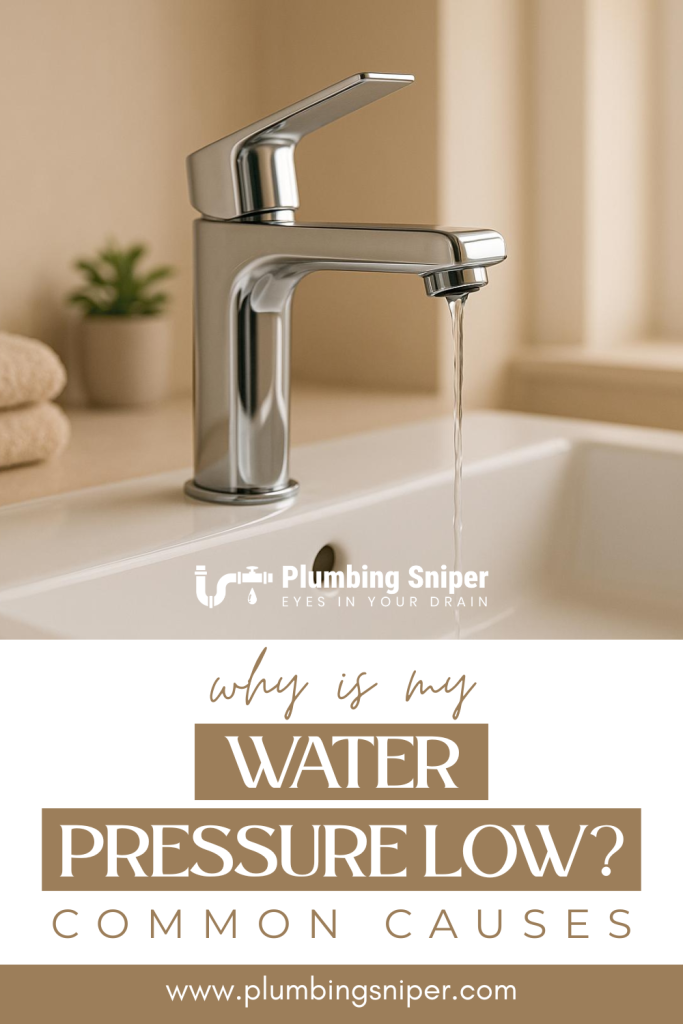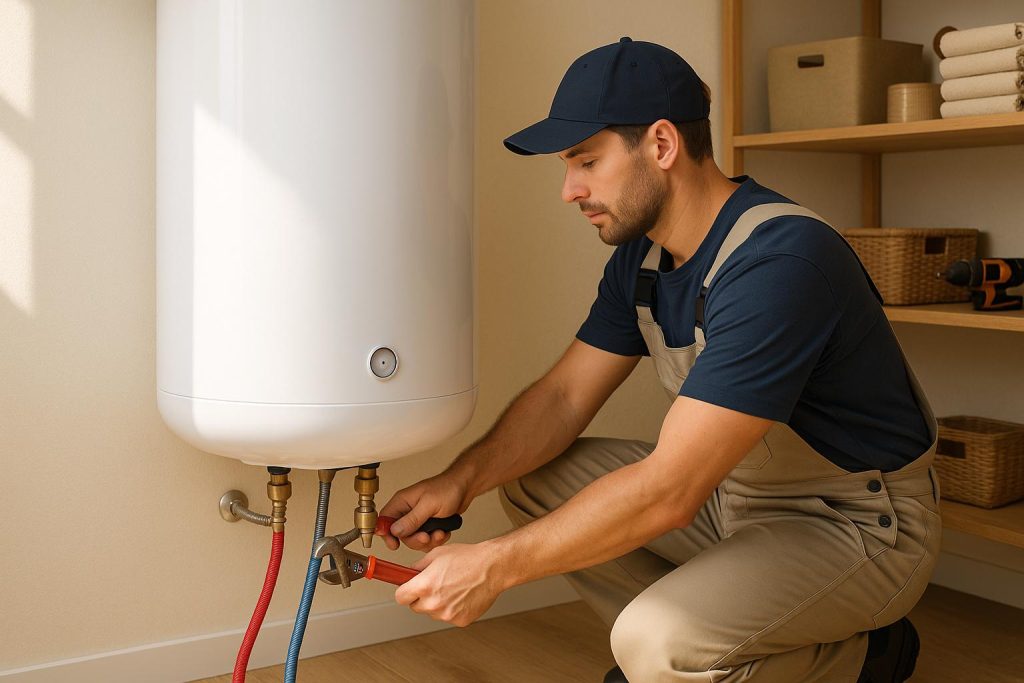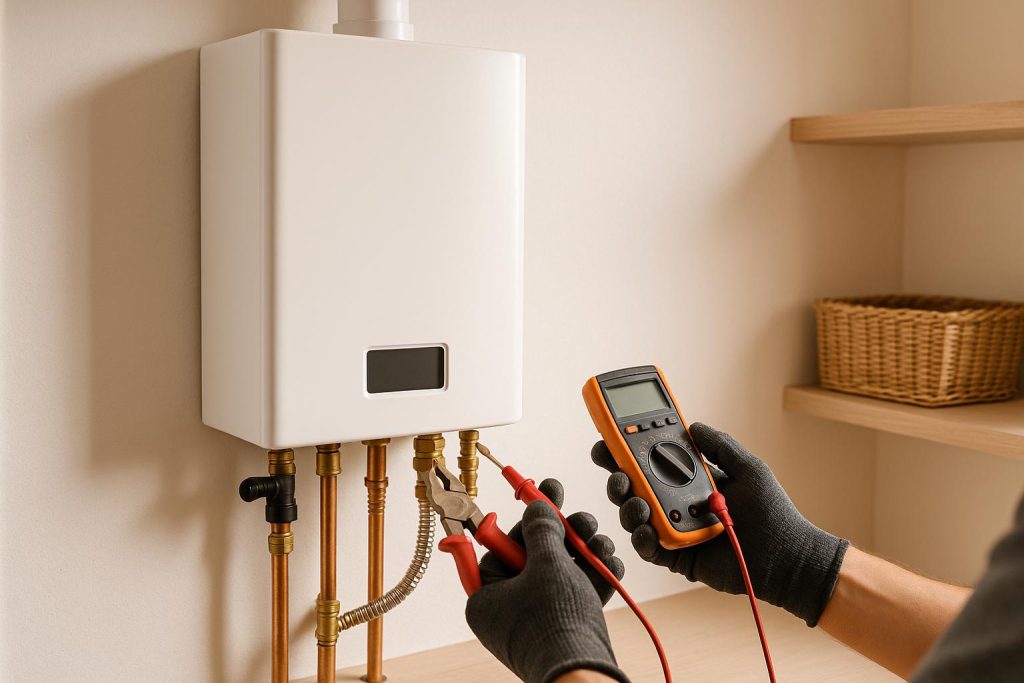Low water pressure can disrupt your daily routine. Whether it’s a weak shower or a slow faucet, the issue often stems from common, fixable causes.
If you’ve ever asked, “Why Is My Water Pressure Low?”, keep reading for the answers.
To save time and prevent further problems, you can always get a free quote from a local plumbing pro here
Here’s a quick rundown of what might be going on:
- Clogged Pipes: Mineral deposits or debris can block water flow, especially in areas with hard water.
- Corroded Plumbing: Old pipes, like galvanized steel, can rust and narrow over time.
- Faulty Pressure Regulator: This device keeps water pressure stable but can fail after 5–10 years.
- Partially Closed Valves: Ensure all water valves in your home are fully open.
- Municipal Water Supply Issues: Sometimes, the problem lies with your local water utility.
To diagnose the issue, check all fixtures, test water pressure with a gauge, and inspect valves. If the problem persists or affects multiple fixtures, it may be time to call a plumber. Regular maintenance, like cleaning aerators and inspecting pipes, can help prevent future issues.
5 Reasons Why Is My Water Pressure Low And How To Fix It
Common Causes of Low Water Pressure
Figuring out why is my water pressure low is the first step to fixing it. Let’s dive into some of the usual suspects that can turn a steady stream into a frustrating trickle. Each issue needs its own approach for diagnosis and repair.
Clogged or Blocked Pipes
Over time, mineral deposits, limescale, and debris can build up inside your pipes, creating blockages that restrict water flow. This buildup often goes unnoticed until the water pressure drops significantly. For example, if your kitchen faucet works fine but the shower barely dribbles, you might be dealing with a localized clog. A quick way to check is by removing aerators from faucets and showerheads. If you find white, chalky deposits or other debris, that’s a sign your pipes might be clogged. Homes in areas with hard water are especially prone to this issue, as minerals like calcium and magnesium tend to accumulate over time.
Corroded Plumbing Lines
Old pipes don’t last forever. Galvanized steel pipes, for instance, typically start to corrode after about 20 years. As pipes age, rust and scale buildup can narrow the pathways for water, leading to lower pressure. Here’s a quick look at how long different pipe materials generally last:
| Pipe Material | Expected Lifespan |
|---|---|
| Galvanized Steel | 20 years |
| Brass | 40–70 years |
| Copper | 50+ years |
If you notice rusty or discolored water along with low pressure, it’s a strong sign that your pipes are deteriorating internally. Galvanized steel pipes are especially prone to rust flaking off, which can create additional blockages downstream.
Faulty Pressure Regulator
The pressure regulator in your home is there to keep water pressure within a safe range, typically between 40 and 60 PSI. When this device fails, it can cause pressure issues throughout the entire house. If your pressure regulator is malfunctioning, it might get clogged, stick in a closed position, or simply wear out over time. Experts recommend replacing it every 5 to 10 years.
To check your regulator, attach a pressure gauge to an outdoor hose faucet. If the reading is below 40 PSI or above 80 PSI, your regulator likely needs attention. Keep in mind, pressure above 80 PSI isn’t just a nuisance – it can damage your pipes, fittings, and fixtures.
Closed or Partially Closed Valves
Your home has several valves that control water flow, and if even one of them isn’t fully open, your water pressure will take a hit. The main shutoff valve is usually where the water line enters your home, while the water meter valve is typically near the water meter itself. Double-check these valves to ensure they’re fully open by turning them counterclockwise. If a valve is stuck or hard to turn, it’s best to call a professional to avoid causing damage.
Municipal Water Supply Issues
Sometimes, the problem isn’t inside your home at all – it’s with your local water utility. Municipal issues like water main breaks, maintenance work, or pressure pump problems can cause low water pressure across an entire neighborhood.
To figure out why is my water pressure low, ask your neighbors if they’re experiencing the same issue or contact your local water utility for updates on service disruptions.
Weather can also play a role. Freezing temperatures can cause pipes to freeze, while droughts can strain municipal water supplies, both leading to noticeable drops in water pressure for entire communities.
Diagnosing the Source of Low Water Pressure
Figuring out why is my water pressure low doesn’t have to feel like solving a mystery. By following a logical process, you can identify whether it’s a quick fix or something that needs a professional touch.
Step-by-Step Troubleshooting
Start by testing each faucet in your home, both inside and outside. Turn them on and check the flow of both hot and cold water. This simple test can reveal whether the issue is isolated or more widespread.
- If only one fixture has low pressure, the problem is likely in that specific fixture or its supply line. Unscrew the aerator and inspect it for any buildup of debris, minerals, or rust. Over time, older pipes can release particles that clog aerators, reducing water flow.
- If multiple fixtures are affected, ensure both the main shutoff valve and individual local valves are fully open.
- If only hot water is running low, the issue might be with your water heater. Check for leaks and clean the screens on your hot water faucets. Often, this points to a problem with the heater’s hot water supply.
For a more precise check, attach a pressure gauge to an outdoor spigot. Ideal water pressure ranges from 40 to 60 PSI. If your reading is below 30 PSI, it confirms low pressure. You can also time how long it takes to fill a one-gallon container to compare flow rates across fixtures.
It’s also worth asking your neighbors if they’re facing similar issues. If they are, the problem could lie with the municipal water supply. Reach out to your water provider to check for any service disruptions or known issues in your area.
By following these steps, you’ll have a clearer idea of whether the issue is something you can resolve or if it’s time to bring in a professional.
When to Call a Professional
If your troubleshooting doesn’t pinpoint the cause or the problem affects multiple fixtures, it’s time to consider expert help. Some water pressure issues are too complex for DIY fixes, and calling a plumber can prevent further problems.
“If you’re having trouble pinpointing the cause of low water pressure to just one fixture or especially throughout your entire plumbing system, it’s time to call a professional plumber.” – Ressler & Mateer
Call a plumber immediately if you experience a sudden drop in water pressure throughout your home. This could signal a serious issue, such as a major leak or pipe failure, that needs urgent attention.
If your pipes are clogged or corroded deep within, professional tools like cable snakes or hydro-jetting equipment may be necessary to clear the blockages. Similarly, water heater problems – such as sediment buildup or internal damage – require professional expertise.
Another situation where expert help is crucial is when your pressure regulator needs adjustment or replacement. This device manages the water pressure for your entire home, and improper handling can lead to bigger plumbing problems. A professional can also advise on installing a pressure booster if needed.
Hidden leaks are another red flag. If you’ve ruled out obvious causes but still have low pressure, there might be leaks behind walls or underground that require specialized detection equipment.
Before calling a plumber, make sure you’ve completed basic checks: confirm if the issue is isolated to one fixture or widespread, clean aerators and showerheads, and verify that all shutoff valves are fully open. Providing these details will help the plumber diagnose and resolve the issue more efficiently.
Solutions and Maintenance Tips
Once you’ve identified the problem, it’s time to choose the right fix to get your water flowing properly again. Whether you’re tackling common issues or planning for long-term maintenance, there are plenty of steps you can take to keep your plumbing in top shape. Some fixes are simple enough to do yourself, while others might call for professional help.
Fixing Common Issues
A quick way to restore water pressure in specific fixtures is by cleaning clogged aerators and showerheads. Remove the aerator from your faucet, soak it in vinegar for about an hour, and scrub off any remaining deposits with an old toothbrush. This easy method clears out mineral buildup, especially in areas with hard water.
For blockages affecting your entire plumbing system, try flushing it out. Start by turning off the main water supply, then open all faucets in your home. Once the water has drained, turn the supply back on to push out any debris or sediment that might be clogging the pipes.
If the issue lies with your water heater, it might be time for some maintenance. Draining and flushing the tank annually helps remove sediment buildup that can restrict hot water flow. If only your hot water pressure is low, this should be your first step.
Wondering why is my water pressure low even after checking fixtures and valves? When a pressure regulator is the problem, replacement is usually the best option. These devices typically last 10–15 years, but wear and sediment can shorten their lifespan. Some experts recommend replacing them every 4–5 years to ensure consistent performance.
For homes with galvanized steel pipes that have become severely corroded, repiping is the long-term answer. Corrosion can choke off water flow over time, so upgrading to materials like copper or PEX tubing is a smart move. These modern materials are less prone to buildup and can often be installed with fewer connections, reducing future maintenance needs.
If you live in an area with hard water, installing a water softener system can help address the root cause of mineral buildup in your pipes and fixtures. This proactive step prevents recurring issues rather than just treating the symptoms.
While fixing problems is important, regular maintenance can go a long way in preventing them from happening in the first place.
Conclusion
Dealing with low water pressure at home doesn’t have to be an ongoing headache. The solution often lies in a step-by-step approach to identify the root cause and addressing it quickly to avoid minor issues turning into expensive repairs.
Start by testing multiple faucets with a pressure gauge to see if the problem is specific to one area or affects the entire house. If the pressure reading falls outside the ideal range of 30–80 psi, it’s likely a system-wide issue.
In many cases, the fix is simple. But if you’re still asking, “Why is my water pressure low?”, and no DIY fix is working, professional help is the next logical step. Acting early can prevent long-term plumbing damage and keep your system running smoothly.
The best way to keep water pressure in check is to combine quick troubleshooting with regular maintenance. By making these steps part of your routine, you can ensure your water pressure stays at an optimal level.
Acting quickly on water pressure concerns can save you from bigger plumbing disasters down the line. Whether it’s corroded pipes or a failing pressure regulator, early intervention is key to keeping your plumbing system in good shape.
FAQs
How can I tell if low water pressure is caused by my home’s plumbing or the municipal water supply?
To determine whether the problem lies within your home or with the municipal water supply, start by checking your water pressure. Use a pressure gauge attached to an outdoor faucet or a washing machine hookup. Typical water pressure in most U.S. homes falls between 35 and 80 psi (pounds per square inch). If your reading is below 40 psi and several fixtures in your home are affected, the issue could stem from the municipal supply.
Another step is to reach out to your local water utility to see if there’s maintenance work or other supply issues in your area. If the low pressure is limited to specific fixtures or parts of your home, the cause is likely internal, such as clogged pipes, a malfunctioning pressure regulator, or a partially closed shut-off valve.
How can I prevent low water pressure in my home?
Keeping your water pressure steady and reliable starts with staying on top of plumbing maintenance. Regularly check for leaks, make sure your water heater is working as it should, and clear out drains to avoid clogs. Over time, mineral deposits can build up inside pipes, so descaling them is a smart way to keep water flowing freely.
Also, double-check that your main water valve is fully open. For added peace of mind, consider booking an annual plumbing inspection with a professional. These straightforward habits can go a long way in ensuring steady water pressure and keeping your plumbing in good shape.
When should I call a plumber to fix low water pressure in my home?
If you can’t pinpoint the cause of your low water pressure, it’s wise to bring in a professional plumber. This becomes especially crucial if the issue impacts several fixtures or your entire home. It could signal a more serious problem, such as a failing pressure regulator, a significant pipe blockage, or even trouble with your main water line.
Professional assistance is also essential if the problem continues after basic troubleshooting steps like cleaning faucet aerators or checking for visible leaks. More complicated issues, such as water heater problems or hidden pipe leaks, are better left to an expert. This approach helps prevent further damage and avoids the risk of expensive repairs.






